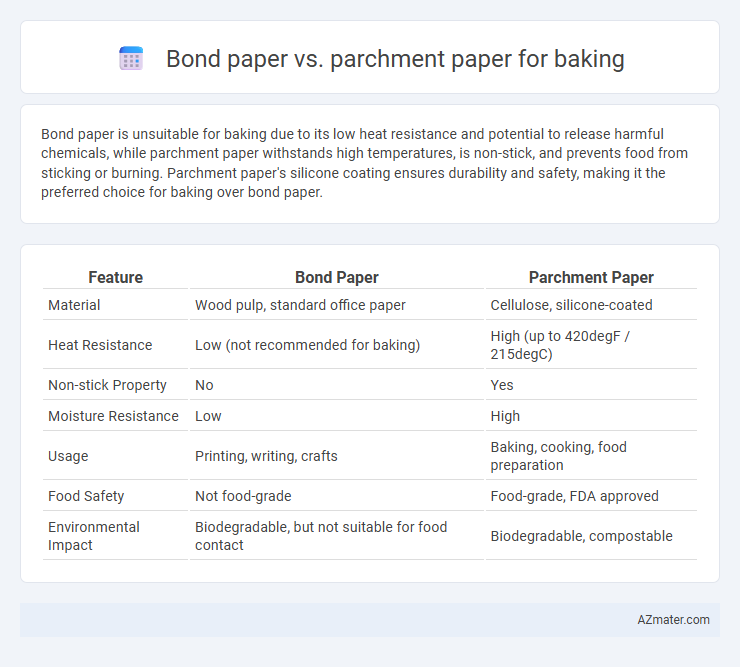Bond paper is unsuitable for baking due to its low heat resistance and potential to release harmful chemicals, while parchment paper withstands high temperatures, is non-stick, and prevents food from sticking or burning. Parchment paper's silicone coating ensures durability and safety, making it the preferred choice for baking over bond paper.
Table of Comparison
| Feature | Bond Paper | Parchment Paper |
|---|---|---|
| Material | Wood pulp, standard office paper | Cellulose, silicone-coated |
| Heat Resistance | Low (not recommended for baking) | High (up to 420degF / 215degC) |
| Non-stick Property | No | Yes |
| Moisture Resistance | Low | High |
| Usage | Printing, writing, crafts | Baking, cooking, food preparation |
| Food Safety | Not food-grade | Food-grade, FDA approved |
| Environmental Impact | Biodegradable, but not suitable for food contact | Biodegradable, compostable |
Introduction: Bond Paper vs Parchment Paper for Baking
Bond paper and parchment paper serve distinct purposes in baking, with parchment paper specifically designed to withstand high temperatures and provide a non-stick surface ideal for cooking and baking. Bond paper, typically used for printing and writing, lacks the heat resistance and food-safe qualities necessary for oven use. Choosing parchment paper ensures even cooking, easy cleanup, and prevents sticking, making it the preferred option in culinary applications.
Understanding Bond Paper: Composition and Uses
Bond paper, primarily composed of wood pulp with a higher cotton content, offers superior durability and strength compared to standard paper types, making it ideal for printing and writing rather than baking. Its ability to withstand ink without bleeding does not translate to heat resistance or non-stick properties required in baking applications. Parchment paper, treated with silicone, provides a non-stick, heat-resistant surface specifically engineered for baking, preventing food from sticking and ensuring even cooking.
What is Parchment Paper? Properties and Cooking Applications
Parchment paper is a heat-resistant, non-stick paper specifically treated with silicone to withstand high oven temperatures and prevent food from sticking. Its moisture-repellent and grease-resistant properties make it ideal for baking cookies, roasting vegetables, and lining cake pans to ensure easy release without greasing. Unlike bond paper, which is designed for writing and printing, parchment paper is tailored for cooking applications requiring durability and heat resistance up to 450degF (232degC).
Heat Resistance: Can Bond Paper Withstand Oven Temperatures?
Bond paper is not designed for baking and generally cannot withstand oven temperatures above 200degF (93degC) without scorching or releasing harmful fumes. Parchment paper, made with a silicone coating, can safely endure temperatures up to 420degF (215degC) to 450degF (232degC), making it ideal for baking tasks. Using bond paper in the oven risks combustion and contamination, whereas parchment provides reliable heat resistance for cooking and baking applications.
Non-Stick Qualities: How Parchment Paper Excels in Baking
Parchment paper features a silicone coating that provides superior non-stick qualities compared to bond paper, ensuring baked goods release effortlessly without residue or tearing. Its heat resistance up to around 420degF (215degC) makes it ideal for high-temperature baking, preventing sticking and promoting even cooking. Bond paper lacks this coating and heat tolerance, increasing the risk of sticking and burning during the baking process.
Food Safety Concerns: Chemical Composition and Suitability
Bond paper often contains additives, bleaches, and non-food-grade inks that pose chemical risks when exposed to baking temperatures, making it unsuitable for direct food contact. Parchment paper is treated with food-safe silicone coatings that withstand high oven temperatures without releasing harmful substances, ensuring safe use in baking applications. Choosing parchment paper minimizes contamination risks and supports food safety standards due to its inert chemical composition and heat resistance.
Baking Results: Texture, Browning, and Release Performance
Bond paper is not designed for baking and can cause uneven browning and sticking due to its lack of heat resistance and release coating. Parchment paper offers excellent browning and prevents sticking, ensuring a consistent texture and easy release of baked goods. Its silicone coating promotes even heat distribution and superior non-stick performance, making it ideal for baking applications.
Environmental Impact: Biodegradability and Reusability
Bond paper is generally not recommended for baking due to its limited heat resistance and poor biodegradability, often containing chemical coatings that hinder composting efforts. Parchment paper, especially unbleached and silicone-coated varieties, offers superior heat tolerance and is typically more biodegradable, although the silicone layer can reduce compostability depending on processing methods. Reusability favors parchment paper as it can be wiped clean and reused multiple times, whereas bond paper deteriorates quickly under baking conditions and is not structurally suitable for repeated use.
Cost Comparison: Affordability and Availability
Bond paper is significantly more affordable and widely available compared to parchment paper, making it an attractive option for budget-conscious bakers. Parchment paper typically costs two to three times more per sheet and is often found only in specialty or grocery stores, limiting accessibility for some users. While bond paper can be a cost-effective substitute, it lacks the non-stick and heat-resistant properties of parchment paper, which may affect baking results.
Final Verdict: Which Paper is Best for Baking Tasks?
Parchment paper is the best choice for baking tasks due to its non-stick, heat-resistant, and moisture-proof properties, ensuring even cooking and easy cleanup. Bond paper lacks the necessary heat resistance and can release harmful chemicals when exposed to oven temperatures, making it unsuitable for baking purposes. For consistent, safe, and high-quality baking results, parchment paper remains the industry standard.

Infographic: Bond paper vs Parchment paper for Baking
 azmater.com
azmater.com